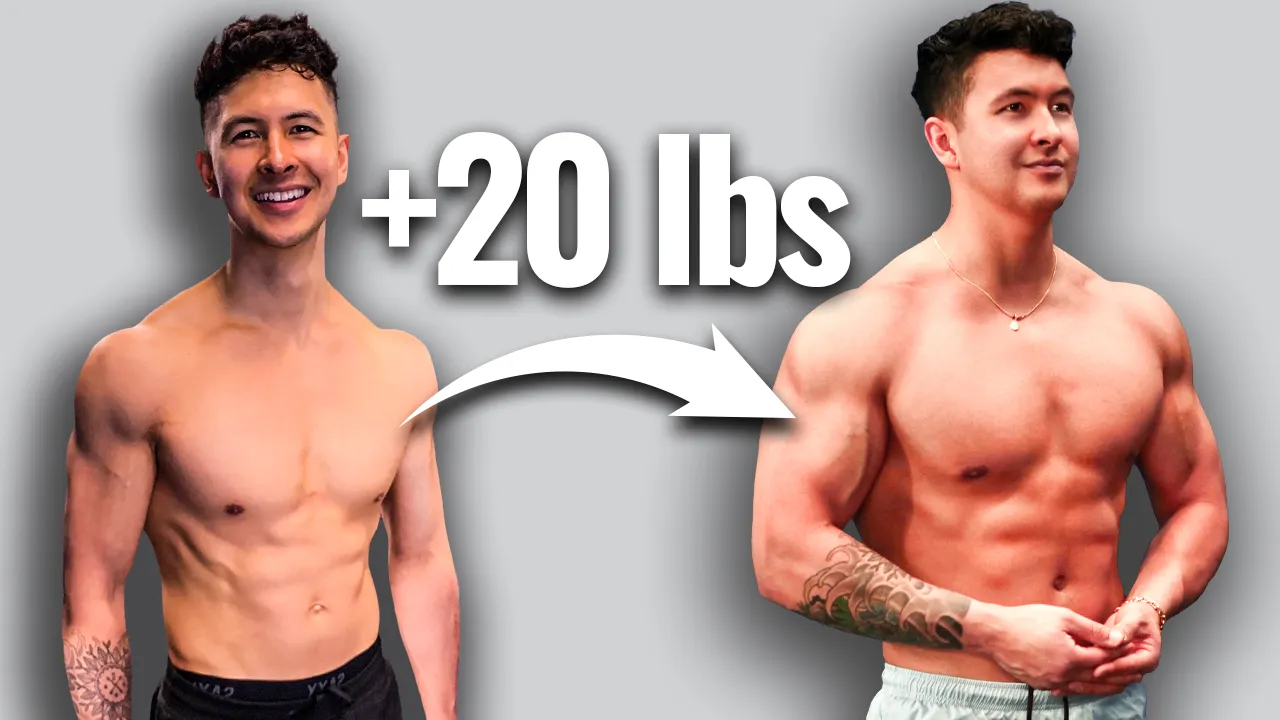
How To Build Muscle FAST (5 Science-Based Steps)
How To Build Muscle Fast For Muscle Growth
Do you want to know how to build muscle fast for maximized muscle growth? Or do you wonder if it's even possible?
It took me years to gain some size and eventually my gains stopped altogether.
Instead of hopping on *ahem* the needle (#nattyforlife), I recently implemented a handful of new research-backed techniques and managed to gain a lean 20 lbs in around 16 months.
My fastest gains since the early days. Here are the 5 things I did.
1) Training For Muscle Growth
Number 1 has to do with my training.
There’s a really exciting new area of research called “stretch-mediated hypertrophy”.
This is something I’ve covered in-depth in a past article, but basically, some muscles seem to grow faster from exercises that challenge them the most when they’re in a stretched position.
This has now been shown with the biceps, triceps, quads, and hamstrings ... and to be honest, it seems like it will be true for most or even all our muscles.
To take advantage of this, there are two things I did.
First, exercise selection. Let’s take the biceps for example.
A recent 2022 study compared two exercises: preacher curls and incline curls.
Preacher curls are most difficult right around here when the biceps are almost fully stretched. Whereas incline curls, based on the incline angle used in the study, are most difficult right a little higher up when the biceps are almost fully contracted.
After 9 weeks of testing the two, the preacher curl led to around 150% more growth.
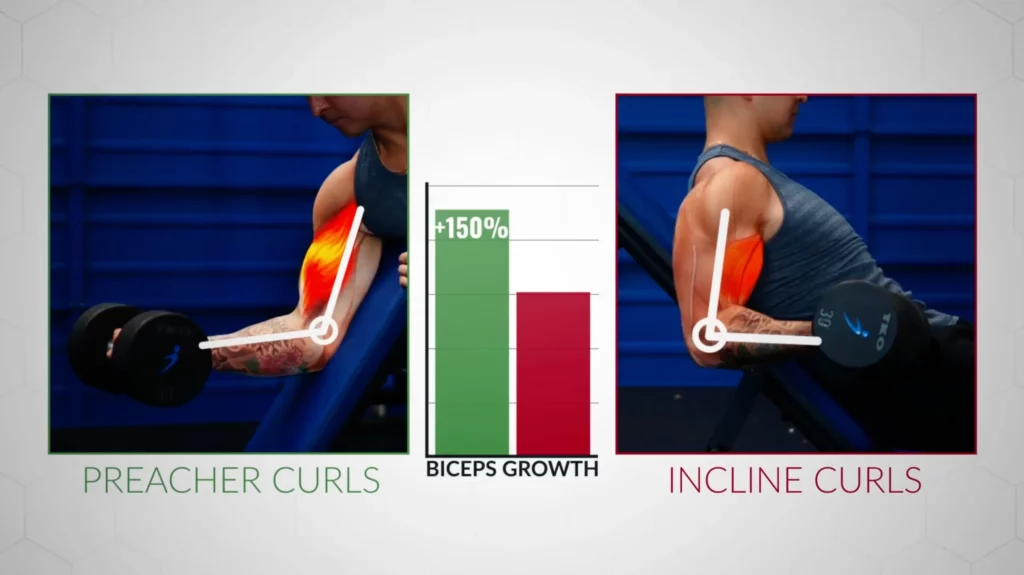
Other recent studies on the biceps have found similar results.
But there seems to be a similar effect with the triceps too. One study had subjects do overhead extensions with one arm and your normal triceps pushdown with the other arm.
Likely because of the greater stretch on the triceps, the overhead exercise led to significantly more growth.

So to apply this, in my weekly routine I made sure I was doing at least one exercise that really challenged each muscle in a stretched position.
Aside from the ones I just shared with you, I also did behind-the-body curls for biceps, behind-the-body cable lateral raises for shoulders, seated leg curls for hamstrings, and Bulgarian split squats for glutes.
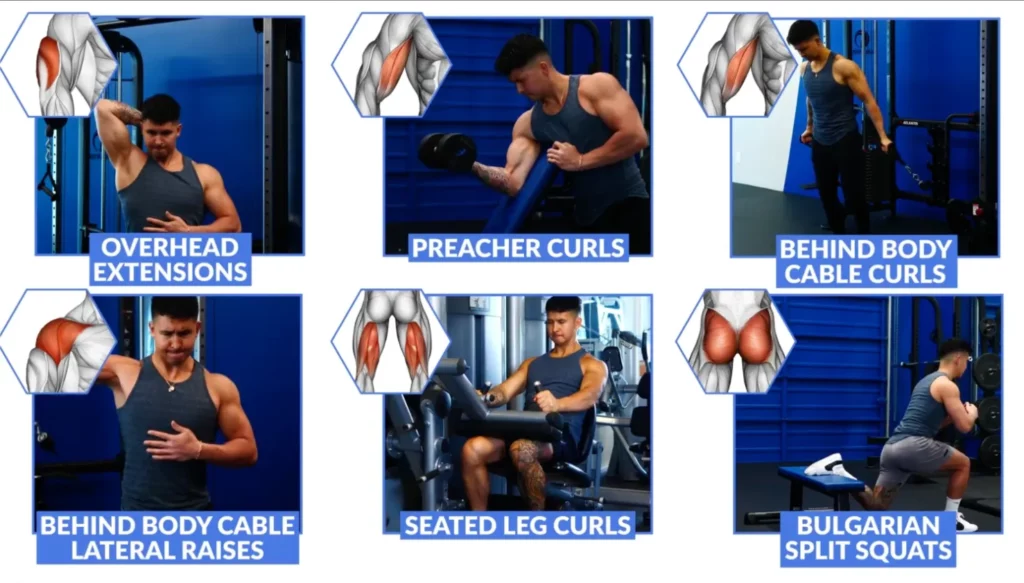
But there’s another thing I did to focus on this “stretched” position even more.
And honestly, I think this is what really made the difference.
So I’ve always obsessed with progressive overload and just lifting more weight and doing more reps every workout.
While important, it’s easy to get carried away.
You start lifting heavier but it comes at the expense of form. You don’t go quite as deep or you start using just a bit more momentum. These little compensations decrease the challenge you put on your muscles in that stretched position.
So although I was lifting heavier overtime, I wasn’t actually seeing very good results.
So I decided to first lighten the weight on almost all my movements by about 10-20%. I then tried to go as deep as I could with good form and for some exercises like presses and squats I also added a half-second pause at the bottom.
Although I wasn’t lifting as heavy, my muscles were challenged so much more, especially during that deep stretch, and they responded extremely well to this.
Your ego might take a hit but if your goal is to build muscle, then honestly forget about how much weight you’re using.
Your goal isn’t to lift as much weight as possible, it’s to use that weight to challenge your muscles as much as possible.
Knowing that will completely change the way you train and save you from a lot of injuries.
2) Effort: Rep To Failure
Now, even if you do all the “best” exercises and use the right form, if you’re not applying this next step you’re not going to grow.
It wasn’t until I fixed this did I realize how much it was holding me back.
So in order to maximize muscle growth, you need to get close enough to failure during each of your sets. Research suggests that at least within 3 reps of failure is the threshold.
The more experienced you get, the more important this becomes.
Now even though I was aware of this, I’ll be honest after I built up a decent amount of muscle I just got comfortable. I wasn’t training as hard as I could have been and was just going through the motions.
It wasn’t until I started pushing myself close enough to TRUE failure that I started really seeing my growth take off.
And let me tell you, it’s very easy to think you’re pushing hard enough when in reality you still have more to give.
A recent meta-analysis released just last year found that in weightlifting studies, subjects would on average stop their sets almost 10 reps before they reached failure. And even well-trained lifters have been shown to underestimate their max effort by around 1-2 reps on average.
Believe me, the difference between stopping a set 3+ reps short of failure compared to pushing through to just 1-2 reps short of failure is a whole other level of pain.

This won’t be comfortable and it never gets easier. But there are a few things I did that helped.
First, I changed my mindset toward the pain. I simply view it as a sensation and I now link that feeling of pain with growth.
So now, it’s almost like my brain is looking forward to and seeking that pain because I know it’s going to result in future muscle growth.
Second, I always take at least a few seconds to just close my eyes and mentally prepare myself for the next set. It’s so easy to let your mind get distracted when you’re working out and start scrolling through social media.
But to push to the levels required to truly force your muscles to grow, you need to get locked in and that happens before you’ve even started your set.
And lastly, there’s no way you’re going to be able to do a crazy amount of volume every workout once you start training with this level of effort.
That’s why it’s essential that you implement point #3, recovery.
3) Recovery
So your workouts are what provide the stimulus for your muscles to grow, but the actual growth happens when they’re resting and recovering.
Contrary to popular belief, this is a major contributor to gain muscle mass.
The thing is, most people think that “recovery” only has to do with your rest days.
But the most important part of managing your recovery actually has to do with your workout programming.
You see, for years I would always train at least 5, 6, and sometimes even 7 days a week.
When I was younger I could do this, no problem.
But over time it became too much. I stopped looking forward to my workouts, had low energy, and my muscles just didn’t recover very well.
So I cut down my workouts to just 5 per week and recently cut it down even more to just 4 slightly longer workouts per week with the occasional accessory day.
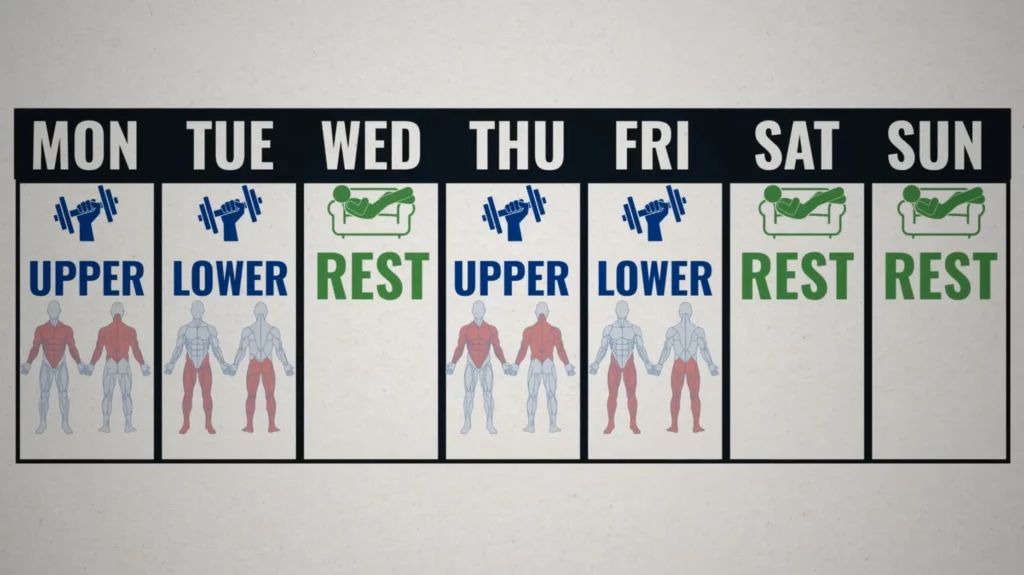
Almost instantly after making this switch I felt MUCH better day to day and a lot more energized going into my workouts.
And I definitely noticed my muscles recovered and grew a lot better as a result.
Don’t get me wrong, you still need to train hard, and you still need to do enough weekly volume to grow.
Research suggests at least 8-10 sets per muscle per week. But more isn’t always better and what someone else can recover from might end up being too much for you.
Keep in mind your workouts aren’t the only stress your body has to recover from.
Your work, life, and relationships are all added stressors. Your body and mind just may not have the recovery capacity to commit to 5+ days a week in the gym, so don’t force it and listen to the signs your body is giving you.
4) Diet
So far we’ve talked a lot about training.
But all that training wouldn’t have done much if I didn’t modify my diet.
You see, to maximize growth, research suggests you probably need to be eating in a calorie surplus, also commonly referred to as a “bulk”.
But just like with workout volume, more calories aren’t always better.
One study compared the effects of a “fast bulk” versus a “slow bulk”. Both groups were in a calorie surplus but the “fast bulk” group ate on average about 600 calories more than the “slow bulk” group.
After 10 weeks, the “fast bulk” group gained more than twice as much weight, about 5 times as much fat, and only a tiny bit more muscle than the slow group which actually didn’t reach statistical significance.
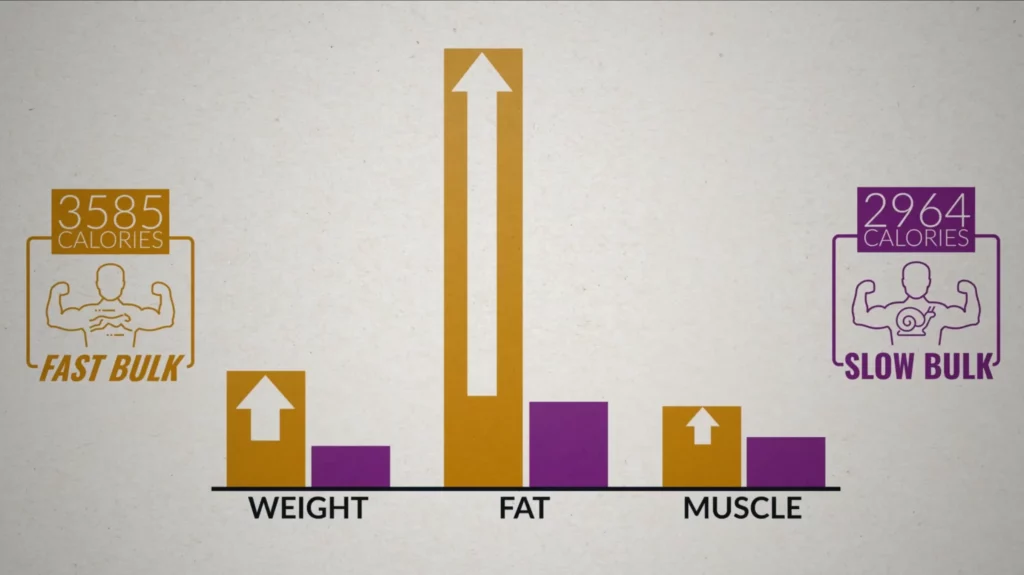
So what I did was a “lean bulk”.
This is when you purposefully overfeed your body with just a bit more than it needs, typically around 10-15% above your maintenance calories.
For me, this started at about 2,900 calories and ended up at a little over 3,000 calories (~3,100 calories) by the end of the bulk.
And if you need some help figuring out the right amount of lean bulk calories for you, you can check out my calorie calculator over here.
However, even with a lean bulk, you probably will still gain some fat.
The 20 lbs I gained definitely was not all muscle. And this can be tough to accept.
It’s hard seeing your abs and muscle definition slowly fade away, especially during summertime, and in my case, it was really hard mentally, especially with all the pressure to constantly be “shredded” for YouTube and social media.
In the past, I’d always go back to dieting whenever I saw a bit of fat gain and so I never really progressed.
This time, I decided to stick through it and I’m telling you it paid off tremendously. So shift your mindset and think of it as a long-term investment.
You have plenty of summers to get shredded in the future, and your body is only going to look even better with more muscle on your frame.
5) Patience/Mindset
So tip number 5 was probably the hardest thing to implement.
You see, fat loss is a relatively fast process. You can easily lose 1-2 lbs of pure fat per week.
But in comparison, once you’re past the beginner stage of training, it can take several months to gain even just 1 lb of muscle.
I mean I gained 20 lbs but not all of that was muscle and it took me almost a year and a half to do.
But don’t let this discourage you. The small gains you make week to week will overtime amount to big noticeable changes.
Our BuiltWithScience.com members here are a perfect example of this and what’s possible if you trust the process.
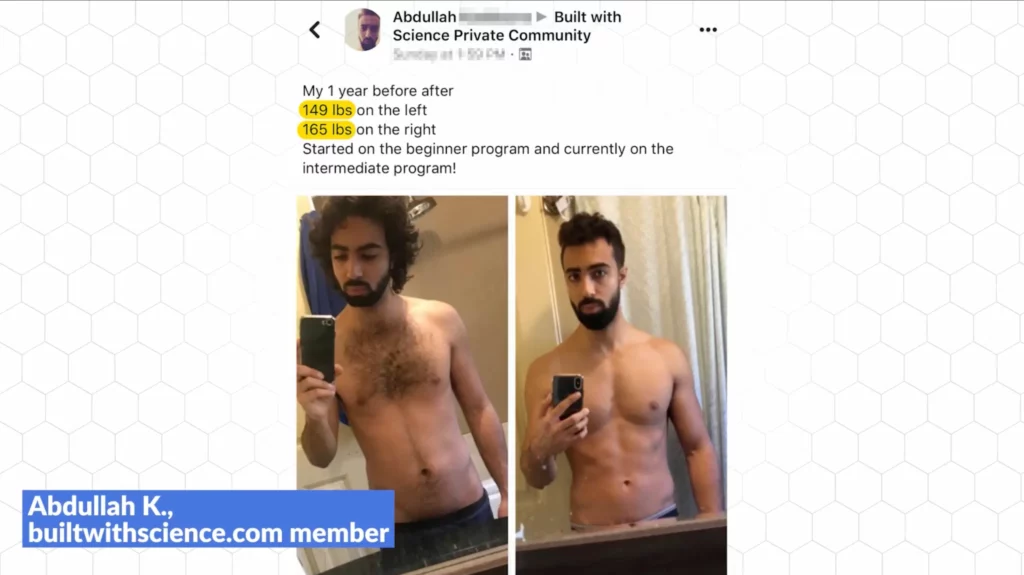

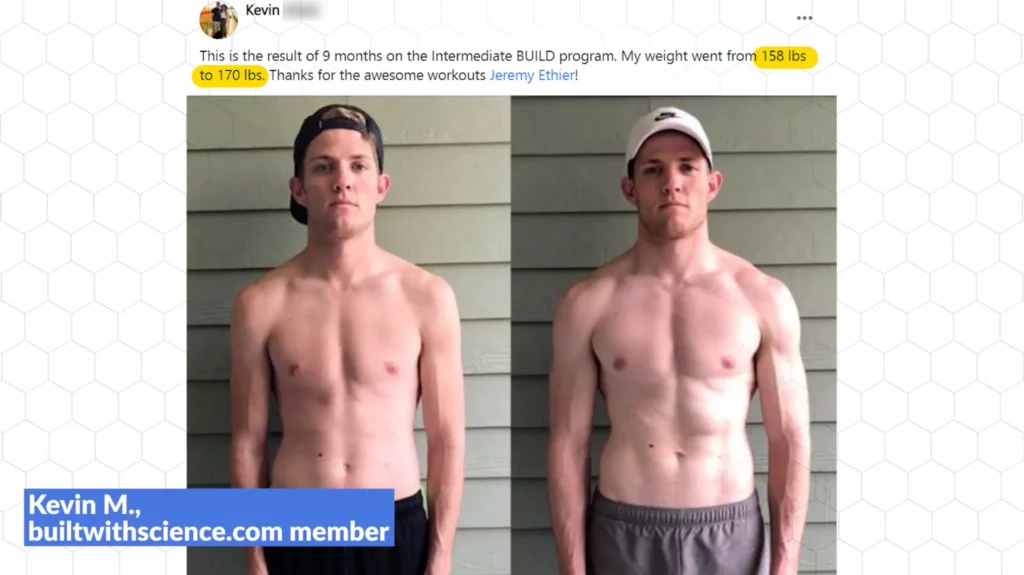

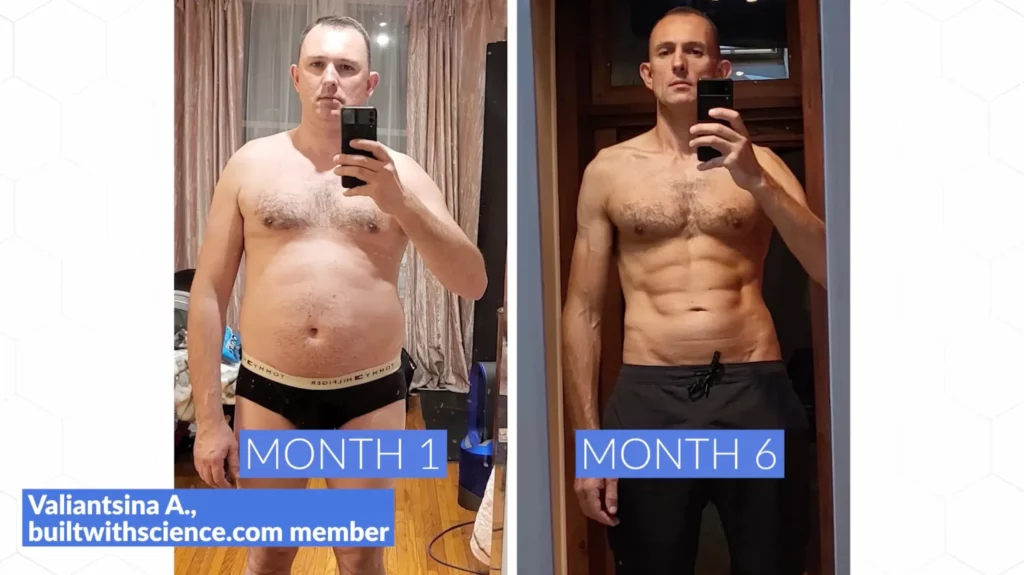
I mean you can see the incredible difference that adding even just 10-15 lbs of muscle to your body can make.
So, be patient and don’t try to rush it.
Give this article a read next to learn more about the muscle stretch research I covered earlier and how to use it to speed up your gains even more. Thanks for sticking to the end, and I’ll see you next time.
And for those who want a done-for-you science-based program that shows you exactly how to train based on your goals, just take our analysis quiz below:
Click the button below to take my analysis quiz to discover the best program for you:
↓








